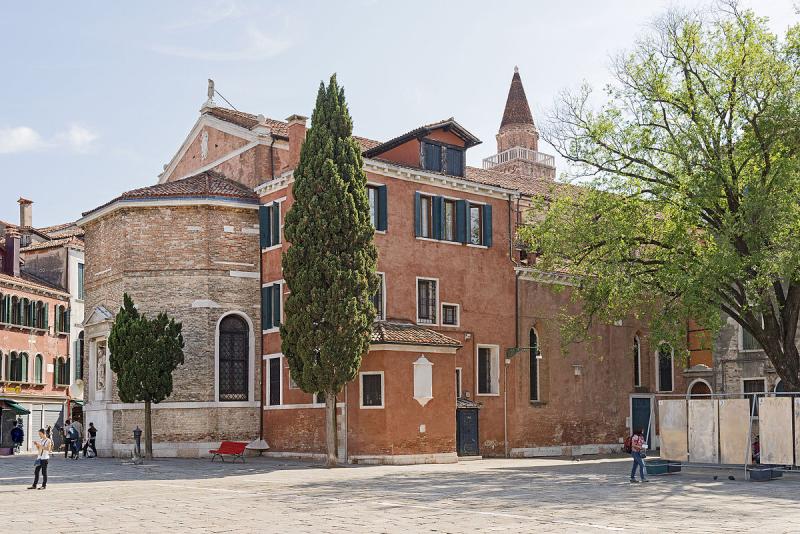Discovering the Church that Gives the Name to Venice’s San Polo Sestiere
ITA:

Use player to listen to Italian version
San Polo is Venice’s smallest sestiere, connected on both sides of the Canal Grande via the famous Ponte di Rialto. It has numerous taverns and the typical bacari, where you can try Venetian dishes and enjoy cicchetti. Throughout San Polo, there are several interesting monuments, among them the Church of San Polo, which gives the name to the sestiere.
The current Gothic church dates from the 15th century, but a church has stood on the site since the 9th century, while the campanile, which is detached from the church, was built in 1362.
Inside the austere interior, you’ll find valuable works of art, including the Last Supper and the Assunta e i Santi by Jacopo Tintoretto. The presbytery area is entirely decorated with paintings by Jacopo Palma il Giovane; on the right and on the left, the Chapel of the Sacrament is frescoed by Salviati, while the altar features the Marriage of the Virgin by Paolo Veronese. The second altar on the left aisle is decorated with Virgin appearing to Saint John by Giambattista Tiepolo.
By the front door of the typical medieval Venetian bell tower, there are two Romanesque sculptures, one of a lion gripping a snake, and the other of a lion holding a human head with its front legs. It is thought that the snake represents the conspiracy headed by Baiamonte Tiepolo in 1310 to overthrow the government of the Republic of Venice, which was crushed by the Council of Ten, established then to monitor the safety of Venice. The council then became famous for being particularly ruthless in eliminating every possible enemy of Venice.
The human head held by the other lion is thought to be that of Francesco Bussone, Count of Carmagnola, captain of the Venetian troops in the war against Milan, which the Venetian Senate accused of treason and had beheaded.
San Polo è il più piccolo sestiere di Venezia, collegato su entrambi i lati del Canal Grande attraverso il famoso Ponte di Rialto. Ha numerose taverne e i tipici bacari, dove si possono provare piatti veneziani e gustare i cicchetti. In tutto San Polo, ci sono diversi monumenti interessanti, tra cui la Chiesa di San Polo che dà il nome al sestiere.
L'attuale chiesa gotica risale al XV° secolo, ma una chiesa sorgeva in questo luogo sin dal IX° secolo, mentre il campanile, separato dalla chiesa, fu costruito nel 1362.
L’interno austero custodisce preziose opere d'arte, tra cui l'Ultima Cena e l'Assunta e i Santi di Jacopo Tintoretto. L'area del presbiterio è interamente decorata con dipinti di Jacopo Palma il Giovane; a destra e a sinistra, la Cappella del Sacramento è affrescata da Salviati, mentre l'altare presenta lo Sposalizio della Vergine di Paolo Veronese. Il secondo altare sulla navata sinistra è decorato con la Vergine che appare San Giovanni di Giambattista Tiepolo.
Alla porta d'ingresso del tipico campanile veneziano medievale, ci sono due sculture romaniche, una di un leone che stringe un serpente, e l'altra di un leone che regge una testa umana con le zampe anteriori. Si pensa che il serpente rappresenti la cospirazione capeggiata da Baiamonte Tiepolo nel 1310 per rovesciare il governo della Repubblica di Venezia, e che fu schiacciata dal Consiglio dei Dieci, istituito per monitorare la sicurezza di Venezia. Il consiglio divenne famoso per essere particolarmente spietato nell'eliminare ogni possibile nemico di Venezia.
Si pensa che la testa umana dell'altro leone sia quella di Francesco Bussone, conte di Carmagnola, capitano delle truppe veneziane nella guerra contro Milano, che il senato veneziano accusò di tradimento e che fece decapitare.











